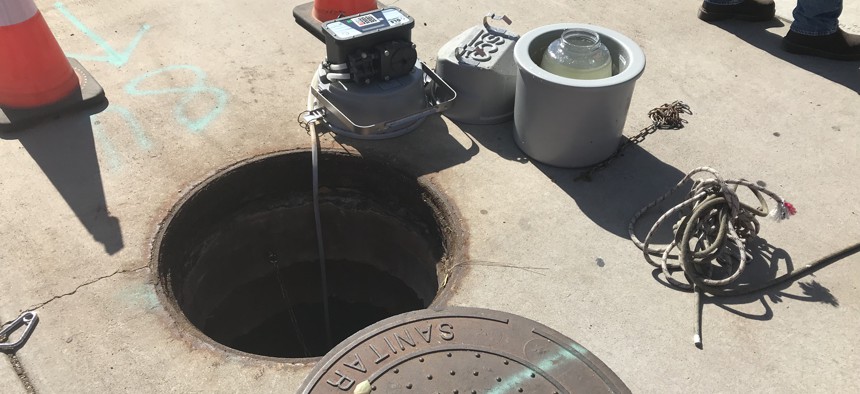A City Looks at Wastewater for Clues in the Opioid Fight

A sampler tapping directly into the sewer through a manhole in Tempe, Arizona. A glass jar of wastewater is also pictured. Erin Driver, Biodesign Institute

Connecting state and local government leaders
Tempe, Arizona tests the waters to glean data about the spread of dangerous drugs.
Over one week each month across Tempe, Arizona, wastewater is sucked up into devices placed in underground sewage pipes. The wastewater is then taken to an Arizona State University lab, tested for the presence of heroin, codeine, fentanyl and other opioids.
The sampling gives officials in Tempe, in partnership with a team at the university, more information about what opioid drugs—both legal and illegal—people are taking in the city just east of Phoenix. But the data isn’t merely sitting on a desk in a government office. Instead, much of the information gathered is posted on a regularly updated online dashboard and map that residents can also see.
The goal of the effort—and a similar dashboard of EMS calls for service related to opioids—is to gather data that can help assess the scope of the opioid crisis in Tempe and whether government efforts are working to help treat people and save lives, said Stephanie Deitrick, the enterprise GIS manager for the city.
On top of that, officials with the city and university hope that as the project moves forward the information won’t just help evaluate the crisis response, but also shape policy and strategies.
“That is the dream. Wastewater can tell you things that it would take you longer to learn from other sources, so you can respond more quickly if you use wastewater,” said Joshua Steele, a PhD candidate in environmental engineering who has worked on the ASU team from the beginning of the project.

Opioid Mapping
In recent years, localities across the country have created and shared with the public opioid maps and dashboards, which have been used, in part, to paint a picture of a crisis that many people likely don’t fully understand. Adam Anderson, the health data and GIS supervisor for the Tri-County Health Department just outside Denver, Colorado, said maps can be particularly useful in driving home the human toll of deaths from opioids.
Unlike a table that might list the people from Adams, Arapahoe, and Douglas counties who died from an opioid overdose, a heat map can drive home to users the scope of the epidemic.
“As soon as you put it onto a map … they understand that it is not just an even distribution across the area. There are certain communities that are disproportionately affected by the problem. And then immediately they are going to try to see, ‘Where does my community fall in that?,’” Anderson said. His agency has put up maps of opioid and heroin overdose deaths, as well as maps for resources, such as drug treatment facilities.
Jeremiah Lindemann, a product engineer for Esri who has used mapping to help with personal advocacy around the opioid epidemic, said most of the focus has been on creating maps to build awareness. But Lindemann said the next step for local leaders will be mining the information to drive strategies to fight the opioid epidemic—such as using maps to identify treatment gaps.
Looking at Wastewater
In Tempe, the wastewater project emerged after an initial city project in 2017 to map EMS calls suspected to be related to opioids. The idea was to get a sense of drug use in the community that wasn’t just focused on overdoses and deaths, Deitrick said.
After the project with ASU’s Biodesign Institute was floated, Deitrick said the city awarded a $35,000 innovation grant to the initiative, which also received financial support from the university. Although it was only for one year, the project has funding to keep going, she said.
Wastewater collection across the city began in 2018. Steele, with ASU’s Biodesign Institute, said the sampling devices tap into the sewer pipes, often through manholes, to collect water over 24 hours. When the water is analyzed, the lab is largely able to detect—and differentiate between—drugs that were taken by a person and those dumped down the drain, such as by somebody flushing leftover prescription pills. The information gathered can then be evaluated to give city officials an estimate of how many people in a given area of the city used a particular opioid.
On the public dashboard for the project, viewers can see the city broken up into areas and the levels of different drugs detected.

Officials said they’ve heard concerns from some residents about whether the wastewater collection could end up detecting their personal drug use or be used for law enforcement purposes. But Deitrick said the information is only used for public health purposes and they have been able to communicate that to people.
Deitrick said part of the usefulness of wastewater analysis could end up being what it tells the city about long-term trends, not just thinking about jumping into action if the wastewater picks up a growth in a particular kind of drug for a couple of months. But there are times when the data gleaned from the wastewater could be used more quickly, Deitrick said.
Andrea Glass, an assistant Tempe fire chief who has worked on the project, said recently four overdoses in a single week caught the attention of city officials. So, they asked ASU to take a look at the wastewater during the next sampling to see if they could detect anything unusual, such as a new product or particularly potent drug, she said.
Testing wastewater could turn into a significant tool in the ever-changing drug landscape.
“If they can give us an alert that we are finding high levels of carfentanil [a particularly strong opioid] or another type of drug that is emerging and we can put on our radar, then we can educate our own emergency response personnel that we have a more potent drug on the market or in the community,” Glass said. Paramedics and others can be prepared that they might need to administer more doses of naloxone, the drug first responders carry to reverse opioid overdoses.
Glass said the city and ASU are also starting to look at both the wastewater and EMS calls for service data to tease out how it can be used. One strategy is using the information to figure out particular communities where the city can target its opioid education campaigns, she said.
“If we can really hone in on where our biggest issues are in the community and start there, then we can branch out and hit the other parts of the city. That is what will help us to have that significant impact in reducing the amount of misuse or abuse in the community,” she said.
Laura Maggi is the Managing Editor at Route Fifty.

NEXT STORY: The New Target That Enables Ransomware Hackers to Paralyze Dozens of Towns and Businesses at Once





